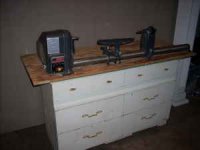Can anyone offer any advice about how good a deal the following might be? It's a 30 year old Craftsman lathe, ostensibly in excellent condition:
12" diameter
Takes up to 35" stock
Multi-speed with indexing feature
Comes with face plate, turning tools and bench mounted with storage drawers
I would appreciate any advice about what to look for in evaluating a used lathe. The seller is asking $125 for the lathe, tools and cabinet (w/drawers) on which the lathe is mounted.
Thanks,
Allan
12" diameter
Takes up to 35" stock
Multi-speed with indexing feature
Comes with face plate, turning tools and bench mounted with storage drawers
I would appreciate any advice about what to look for in evaluating a used lathe. The seller is asking $125 for the lathe, tools and cabinet (w/drawers) on which the lathe is mounted.
Thanks,
Allan

